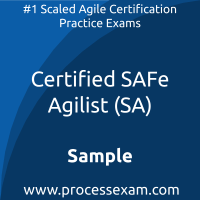 You have to pass the SA exam to receive the certification from SAFe. To increase the effectiveness of your study and make you familiar with the actual exam pattern, we have prepared this SAFe Agilist sample questions. Our Sample SAFe Agilist Practice Exam will give you more insight about both the type and the difficulty level of the questions on the SAFe Leading exam.
You have to pass the SA exam to receive the certification from SAFe. To increase the effectiveness of your study and make you familiar with the actual exam pattern, we have prepared this SAFe Agilist sample questions. Our Sample SAFe Agilist Practice Exam will give you more insight about both the type and the difficulty level of the questions on the SAFe Leading exam.
However, we are strongly recommending practice with our Premium Certified SAFe Agilist (SA) Practice Exam to achieve the best score in your actual SAFe SA Exam. The premium practice exam questions are more comprehensive, exam oriented, scenario-based and exact match of SAFe Agilist exam questions.
SAFe Agilist Sample Questions:
01. What is the most critical move that organizations must address to achieve flow?
a) Hiring, coaching, and mentoring innovation and entrepreneurship in the organization’s workforce.
b) Applying continuous exploration, the process of constantly exploring the market and user needs.
c) Shifting from a start-stop-start project management process to an agile product management approach.
d) None of them.
02. Which of the below does allow new, higher priority work to enter and leave the system with less wait time?
a) Keep team and program backlogs short and largely uncommitted.
b) Establish WIP limits for each process step.
c) Be especially careful of large, long-term commitments.
d) None of them.
03. How the continuous research activities are directly supported through?
[choose three]
a) Continuous exploration in the continuous delivery Pipeline.
b) The feedback loops that exist between the solution and the solution context.
c) Product telemetry data.
d) Better budget.
04. Which of the below substantially minimizes the cost of delay and provides the ability to deliver value continuously?
a) Kanban board.
b) None of them.
c) Continuous delivery pipeline.
d) Scrum framework.
05. Why do organizations struggle to achieve business agility as per Mik Kerston?
a) They are copying managerial frameworks and infrastructure models from their competitors.
b) They are using managerial frameworks and infrastructure models from past revolutions.
c) They are not realizing that they need to transform.
d) They are not adopting new technologies.
06. Who are key stakeholders on the ART who must evaluate fitness for use and actively participate in certain ART events?
a) Agile leaders.
b) Business owners.
c) ScrumMasters.
d) Project managers.
07. Which of the two factors do the economically optimal batch size depends on to reduce WIP?
[choose two]
a) Holding cost.
b) Waiting cost.
c) Transaction cost.
d) Development cost.
08. Organizational agility, lean-agile leadership, and agile product delivery are part of ………………
a) The part of the sprint framework.
b) The part of design thinking.
c) The part of core competencies of business agility.
d) The part of the customer management framework.
09. To achieve meaningful and lasting change, author John P. Kotter notes that a “sufficiently powerful guiding coalition” of stakeholders is needed. What does such a coalition require?
[choose three]
a) Sufficient organizational credibility to be taken seriously.
b) Practitioners, managers, and change agents who can implement specific process changes.
c) Leaders who can set the vision, show the way, and remove impediments.
d) The investors who can support right decisions.
10. Which is not one of the four core values that define SAFe’s essential ideals and beliefs?
a) Alignment.
b) Teamwork.
c) Built-in quality.
d) Transparency.
Answers:
Question: 01
Answer: c |
Question: 02
Answer: a |
Question: 03
Answer: a, b, c |
Question: 04
Answer: c |
Question: 05
Answer: b |
Question: 06
Answer: b |
Question: 07
Answer: a, c |
Question: 08
Answer: c |
Question: 09
Answer: a, b, c |
Question: 10
Answer: b |
If you find any errors or typos in Certified SAFe Agilist (SA) sample question-answers or online SAFe Leading practice exam, please report them to us on feedback@processexam.com
 You have to pass the SA exam to receive the certification from SAFe. To increase the effectiveness of your study and make you familiar with the actual exam pattern, we have prepared this SAFe Agilist sample questions. Our Sample SAFe Agilist Practice Exam will give you more insight about both the type and the difficulty level of the questions on the SAFe Leading exam.
You have to pass the SA exam to receive the certification from SAFe. To increase the effectiveness of your study and make you familiar with the actual exam pattern, we have prepared this SAFe Agilist sample questions. Our Sample SAFe Agilist Practice Exam will give you more insight about both the type and the difficulty level of the questions on the SAFe Leading exam.